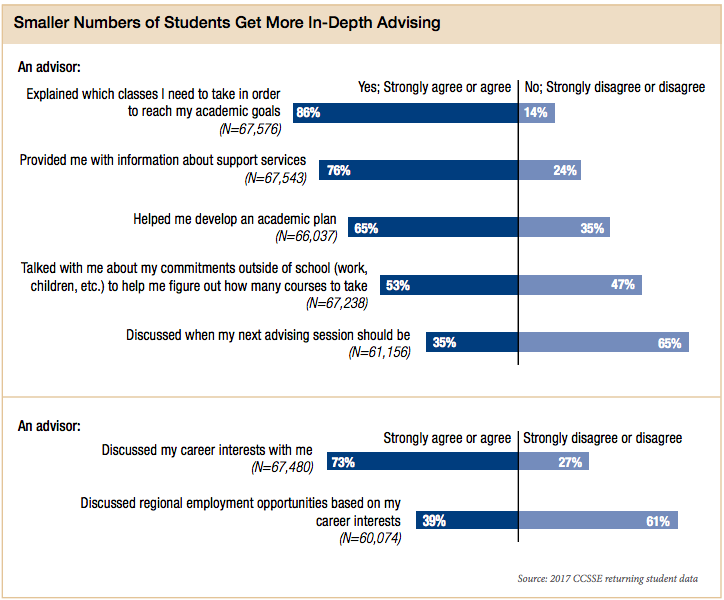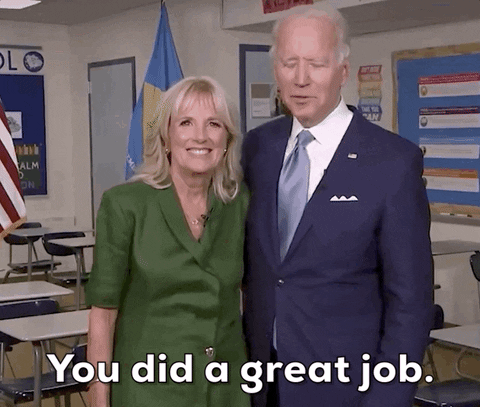Student affairs doesn’t have an official battle cry, but if it did, I imagine it’d be something like “Student engagement leads to student success which leads to increased retention!”
Can’t you imagine thousands of SA pros gathering in a field to shout that victoriously? (After we’ve all added the event to our calendars and set up away messages, of course.)
Engagement is our passion, and increased retention is the Holy Grail result. And next year, we’ll have someone in the White House who is also extremely passionate about collegiate retention: Soon-to-be First Lady Dr. Jill Biden (emphasis on the Dr., thanks very much).
Not only does Dr. Biden plan to continue spending her days with college students after she moves into the White House (as a professor of English at Northern Virginia Community College), but she also focused on collegiate retention in her 2006 dissertation. The dissertation, which earned her a Doctorate in Education from the University of Delaware, was titled Student Retention at the Community College: Meeting Students’ Needs.”
Dr. Biden primarily focused on the retention trends at Delaware Technical & Community College, where she was an English and writing instructor at the time. But, she also pointed out broader changes that all community colleges nationwide should make in order to better support student academic success and ultimately boost retention.
This is exciting history! No matter your political beliefs, it’s quite notable to have a First Lady who has done her homework on community college retention.
Just as I get excited about the Bidens sharing my love of my dogs, I’m intrigued by Jill sharing my interest in higher education. So, I did some digging and found that her dissertation had four recommendations for community colleges seeking to boost retention:
- A mandatory study skills course
- Better academic advising
- A student center or other central place for students to gather
- A wellness center and access to mental health resources
So, let’s follow the doctor’s lead and explore these recommendations. I’ll share some research that supports Dr. Biden’s proposals, along with resources and tools that allow student affairs professionals to get directly involved in these efforts.
4 Proposals
1. A mandatory study skills course
Incoming college students might have aced their study skills back in high school, but college essays and exams present tougher challenges — especially for adult learners who may be many years out of practice.
Or as Clarke Life University puts it:
“College students have an increase in personal responsibility and a lot less external structure. There are no set study times, no required meal times, no one to tell them when to sleep or get them up, an increase in their academic workload, a greater need to multitask and balance, and a myriad of new social opportunities and challenges.”
So, students shouldn’t just be thrown into the collegiate deep end and expected to swim. They need strategies for navigating academic demands so that their grades don’t sink… along with your institution’s enrollment numbers.
Study skills courses can help! Trained educators can guide students through key tricks and tools in order to gain the confidence to turn in stellar essays, focus during study time, and think critically about exam questions.
For inspiration, read about the courses offered at Seminole State College, The University of Tampa, Portland Community College, Macomb Community College, Southwestern College, and Shoreline Community College. I also recommend this article (and accompanying audio reporting) about the University of West Florida’s College Survival Skills Course.
In addition to emphasizing study skills, many of these courses also help students manage stress, assess their personal strengths, set long-term goals, connect with campus services, and more.
If you, as a student affairs professional, don’t have the power to create a study skills course for your institution, don’t fret; you can help students learn these skills in other ways. One avenue is through your website. Consider compiling a list of campus and external resources for students to review, as Salt Lake Community College and Nassau Community College have done.
And don’t forget about the power of co-curricular programming; the guest speakers you host, activities you run, and discussions you hold can impart great study skills wisdom onto students, too! You could run this time management workshop designed by American University, stream a TED Talk about goal setting, or facilitate one of these group activities about productivity, to name just a few possibilities.
Better yet, you could build intentional connections between all your programs in order to gamify learning and set students off on learning pathways towards obtaining excel skills. Essentially, you could build an interactive student skills program composed of multiple co-curricular activities run by you and your coworkers! (Check out our Complete Guide to Co-Curricular Learning to get started.)
Mohave Community College has a great summary of top study skills, and I previously assembled 128 resources that students and SApros can utilize in boosting their productivity and wellness. The apps, videos, worksheets, and webinars listed can help you intentionally empower students with the skills they need to succeed inside the classroom and therefore, persist towards degree attainment.
2. Better academic advising
According to a 2018 report by the Center for Community College Student Engagement, 78 percent of students returning to their community colleges report meeting with an academic advisor, which is 16 points higher than the 62 percent of entering students who report the same thing. The report concluded that “as less than 50 percent of first-time-in-college students return to the same institution the following fall, this discrepancy suggests that early advising might contribute to increased retention.”
Additionally, 92 percent of returning students surveyed described academic advising as important to their personal experience, with 68 percent calling it “very important.” This is great news for the power of academic advising!
Yet, the same report found that not all advising is created equal. Content matters, and many students are not receiving the sort of content that would potentially be the most impactful to them during academic advising sessions. The graphs below showcase these gaps.

So, in order to better support students (and thus increase retention), better academic advising is crucial. This ACC&U News article and this Inside Higher Ed piece have great analyses and summaries of those needed improvements.
In addition to the advice suggested by the CCCSE report’s findings, here are some other resources to supports academic advisors and other student affairs professionals seeking to advance advising initiatives at their institutions:
- Maximize Your Virtual Academic Advising Sessions with These 10 Tips
- 4 Essential Boundary-Setting Techniques for Academic Advisers
- 8 Essential Questions to Ask Students in Career and Academic Advising Sessions
- 5 Pervasive Myths About Academic Advising that SA Pros Can Help Bust
The National Academic Advising Association (NACADA) also has this wonderfully extensive list of resources for advisors, plus another list specific to advisers at community colleges and other two-year colleges.
Advisers can also join NACADA’s Two-Year College’s Advising Community to take part in continued discussions with colleagues across the country.
3. A student center or other central place for students to gather
Peer relationships are key to student success. Anyone engaging with college students today will see ample anecdotal evidence of this fact. Plus evidence-based research — such as the studies here, here, and here — back up our eyes and ears.
“I think if my experience was only academic, it would have been far harder to stay engaged. The first month or two I was only there for class, and hated how that felt. When I put myself out there and met a few people, a lot changed, quickly. I started sticking around campus between classes and getting to know other students and my club advisors better. Camaraderie is huge in anything difficult, and school is tough for many. For me, it’d been years since I graduated high school. Making connections with peers and mentors was far more impactful for me than the academic lessons.” — Presence’s Andy Gould on his experiences as a student at State College of Florida
Yet, making friends can be a much harder mission for community college students than for their residential peers. When you take away residence life and add in extra responsibilities (such as child care and part-time jobs that more community college enrollees tend to have), making friends doesn’t happen so naturally for anyone.
That’s why student centers are so helpful; they allow students to mix and mingle between classes. Community colleges like Hagerstown, Salt Lake, and Hawkeye fill their student centers with food courts, student org meeting rooms, veterans resource centers, college ID offices, bookstores, information desks, parking permit offices, and much more.
If your community college doesn’t have a student center (or if its location is less than ideal for many students), you can still create opportunities for relationship-building through programming. Here are some ideas previously assembled on the Presence blog:
- 75 Fantastic Program Ideas for First-Year Students
- 53 Virtual Activity Ideas to Keep College Students Engaged During COVID-19
- 105 Adulting 101 Program Ideas
- 100 Budget-Friendly Programs to Add to Your Repertoire
Additionally, to help you better advertise and market your programs, check out 26 Marketing Ideas for Campus Programs That Break the Usual Mold. Plus, this list of 30 unique student orgs might inspire you or your students to start your next wonderfully bizarre group. (Bad Movie Club, anyone?)
“Across all studies, there were positive associations between student engagement and both the number of terms enrolled and credit hours completed.” — Student Engagement and Student Outcomes: Key Findings from CCSSE Validation Research
4. A wellness Center and access to mental health resources
Student affairs professionals might be highly invested in our students’ mental health, but sadly, holistic wellness is often ranked low on the long list of an institution’s financial priorities — especially at community colleges.
In a 2019 Inside Higher Ed article about Harrisburg Area Community College scrapping its on-campus clinical counseling services, author Greta Anderson wrote:
“Four-year institutions are allocating larger portions of their budgets to mental health services for students, and they are feeling some financial strain. But community colleges — largely underfunded and facing declining enrollment — are seriously struggling to cover, much less keep up with, the high costs of providing those services.”
Yet, students could really use these services. In 2016, the Wisconsin HOPE Lab found that almost 50 percent of the 4,000 community college students surveyed across 10 campuses had a current or recent mental health problem — with 36 percent of respondents living with depression and 29 percent struggling with anxiety.
Additionally, the HOPE Lab found that roughly 88 percent of community colleges do not have a psychiatrist or other licensed prescriber to write prescriptions, and 57 percent do not provide suicide prevention resources.
All of this isn’t to say that every community college is devoid of mental health services. Community College of Philadelphia, Shoreline Community College, Monroe Community College, and Tallahassee Community College all offer students counseling sessions with licensed professionals. And many community colleges are adapting to the pandemic by offering remote sessions via secure phone lines and video calls.
Student affairs professionals can encourage students’ use of these services by helping to destigmatize therapy and mental illness. For some tips, check out our podcast episode all about normalizing mental health conversations, along with this blog post about how to dispel harmful mental health myths on your campus.
Kognito also has some great tips specific to community colleges, and the Jef Foundation offers a myriad of resources for teens and young adults seeking to learn more about mental illness diagnoses and coping strategies. I’m particularly impressed by all the resources provided by California Community Colleges Health & Wellness Program.
Connecting students to better mental health services can even have a direct impact on retention! According to data from The Healthy Minds Network, treating 100 depressed students can possibly avert six dropouts in a single academic year.
In addition to referring students to licensed counselors, student affairs professionals can also help students sustain daily happiness through popular wellness initiatives. We previously wrote about how SA pros can better engage the healthy majority, how you can engage students in mindfulness practices virtually, and five mindsets that will help students shift from surviving to thriving in college. You can also connect more students to your campus’s wellness center, counseling services, or victim advocacy office utilizing these tips.
The challenge of increasing community college retention can’t be solved in a day or even a year. But, as Dr. Jill Biden (and I) believe, there are some crucial steps that institutions can take to slowly but surely increase student academic success and persistence numbers — with help from enthusiastic student affairs professionals.

Now, we’d love to hear from you. How are you following the doctor’s orders? Connect with us on Twitter @themoderncampus.





